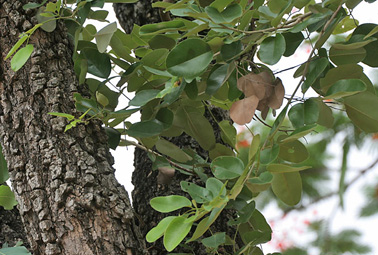|
Botanical Name:
Pterocarpus santalinus
Raktacandana consists of heart wood of Pterocarpus
santalinus Linn, Family Fabaceae
Common Name(s) in English & Indian Languages
Sanskrit: Raktanga, Ksudracndana, Raktasara
Assamese: Sandale, Sandal Ahmar
Bengali: Raktachandana
English: Red Sanders, Red Sandal Wood
Guajarati: Ratanjali, Lalchandan
Hindi: Raktachandanam, Lalchandana
Kannada: Raktha Chandanam
Malayalam: Rakta Chandanam
Marathi: Rakta Chandana
Punjabi: Lal Chandan
Tamil: Senchandanam
Telugu: Erra Chandanamu
Urdu: Sandal Surkh
Botanical
description:
It is a light-demanding small tree growing to 8 m tall with
a trunk 50–150 cm diameter. It is fast-growing when young,
reaching 5 m tall in three years even on degraded soils. It
is not frost tolerant, being killed by temperatures of −1
°C. The leaves are alternate, 3–9 cm long, trifoliate with
three leaflets. The flowers are produced in short racemes.
The fruit is a pod 6–9 cm long containing one or two seeds.
The heartwood as occurs in trade is long and rectangular,
lumpy with removed barks or slices, yellowish brown
-yellowish orange, 1 m long, and 7 ~ 15 cm wide. The
cross-section is exhibited with dark and faint colored
layers like the annual rings; the texture is hard, difficult
to snap off, and fibrous. It smells characteristic, and is
tasteless.
Parts used:
Heart wood
Major chemical constituent:
Anthocyanin, Saponins, Tannins, Phenols, Triterpenoids,
Flavonoids, Glycosides, Glycerides
Therapeutic uses:
• Emesis (Chardi)
• Thirst (Trsna)
• Vitiation of Blood and its components (Raktadosahara)
• Skin disease (Tvara)
• Ulcer (Vrana)
|
|


|
|
|



